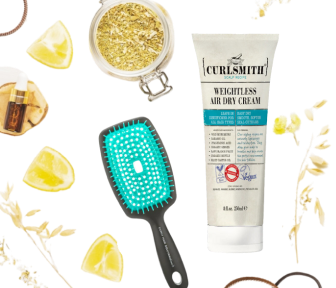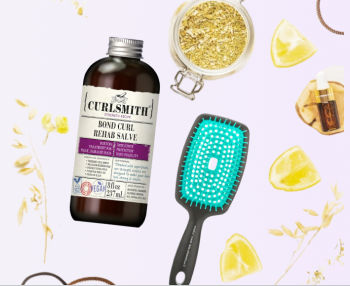If there is one subject that gets talked about a lot in the wavy/curly/tight curls world it is FRIZZ! Some embrace it while others do everything they can to banish it. But one thing is true: we will all have some frizz and we will all have different levels of loving or hating it.
What is frizz? What causes frizz?
Frizz is multiple hairs running in multiple directions and it is more pronounced when the cuticle is slightly lifted.
Let’s review the usual reasons for frizz.
Environment - We all live somewhere that is either humid or dry or somewhere in between! Maybe it changes depending on the time of year. Generally I follow a similar routine all year long and make tweaks based on what I see or feel. Living on the South Coast of BC, it is usually humid and rainy and yes my hair can puff up just a bit too much for my liking.
If the weather is very rainy I will make sure that my primer has film-forming humectants and sometimes protein. Film forming ingredients are as described: they surround your hair and form a film over it to hold the hairs together in that shape. Glycerin has gotten a bit of a bad rap only because in really high humidity as a simple humectant it might “give out”. Just remember, other simple humectants (propylene glycol, sorbitol) will act similarly and they don’t always fail for each person. Don't cut this ingredient out unless you know for sure it doesn't work in your climate. The ones that may work better are your plant gels such as aloe vera, etc.
The next product you put in your hair, either gel or foam (or sometimes both), needs to pretty hard holding if you live in a humid environment. This means my hair won’t be soft or touchable because I want it to stay in that shape for a few days. Some of us don’t like that feeling. If that's you, all that means is that you may have to do your hair more often or do a full wet refresh daily.
And for comparison… I have also lived in Calgary where it is really dry and - at times of the year - super cold. My routine for the weather extremes in both places is pretty much the same when it comes to going for a “relatively frizz free” wash day: film-forming humectants in my primer, protein and a hard hold in my styler.

Diameter/Texture - Hair is usually fine, medium or coarse in texture. Quite often you will notice you have all 3 textures on your head! The thicker/coarser hair texture is not as bendable as the others and so this can result in more frizz. It takes longer to dry and will feel dryer than the other textures.
Level of curliness - More curls means less alignment. Wavy hair will be a bit less frizzy than curly or coily hair by nature.
Damage - This refers to heat and chemical (colour, highlights) etc. damage. If you’ve been straightening your hair for years and you are trying the Curly Girl / Curly Hair Method it is going to take time and a few haircuts for that damage to grow out. Colour and highlights both lift the cuticles in order to deposit the new colour and a lifted cuticle will be more frizzy. This type of hair needs bond rebuilding products like Olaplex.
Now that we know what can cause frizz, let's move on to how to help reduce it.
My Top 12 Tips to Reduce Frizz
-
Get a good haircut. Preferably from someone with training in curly or textured hair.
-
Use a gentle shampoo. Some examples of shampoos that are gentle enough to use as often as needed are the TreLuxe Curl Renew & Restore Gentle Cleansing Rinse and Innersense's Pure Harmony Hairbath.
-
Follow it up with a moisturizing conditioner. Well-moisturized hair is less frizzy. You can try the Flora & Curl Hydrate Me Organic Rose & Honey Cream Conditioner or Ecoslay's Banana Cream Deep Conditioner.
-
Brush with a wide toothed comb or Flexy Brush. This can help evenly distribute your styling products for better coverage.
-
Use a microfibre towel or drying gloves or an old, soft, 100% cotton t-shirt for drying. Regular terry cloth bath towels can remove too much moisture from your hair. Be gentle when drying your curls.

-
Diffuse or hood dry with low-med heat and don't move it around too much. The faster your hair dries, the more defined your curls are likely to be. This usually means less frizz. If air drying works best for you, try not to disturb your hair too much when it is drying.
-
Don't brush your hair when it's dry. This can lead to breakage which also results in that frizzy look.
-
Don’t touch your hair when it is drying. If you want defined curls, ensure that your hair is completely dry before scrunching out a gel cast.
-
Use film-forming humectants. These help smooth unruly frizz in to other strands. Some examples of products with film-forming humectants are: Ecoslay Orange Marmalade, Original Moxie Hold Up Defining Serum, and Original Moxie Mane Tame Weightless Frizz Control.
-
For the least amount of frizz when your hair dries, style very damp or soaking wet. Don't be afraid to add more water when applying your styling products.
- Sleep on a satin or silk pillowcase to protect your hair at night and reduce breakage.
- Use bond repair products if you colour/highlight your hair or have other damage (like from regularly straightening). This will improve your overall hair health. Some examples are the Olaplex No. 3 Hair Perfector and the Curlsmith Bond Curl Rehab Salve.
And last but not least - embrace it! Curly hair is naturally frizzier than straight hair. That's just the way it is. You can follow the tips above to help reduce it but don't be afraid of a bit of frizz and don't feel you need to fight with your hair to get a certain look. Your hair is yours, and it is unique. Have fun with it!
Photo of woman drying her hair is from Flora & Curl.








